Previous issues
- Page Path
- HOME > Browse Articles > Previous issues
- [English]
- Lithium-silicate coating on Lithium Nickel Manganese Oxide (LiNi0.7Mn0.3O2) with a Layered Structure
- Dong-jin Kim, Da-ye Yoon, Woo-byoung Kim, Jae-won Lee
- J Korean Powder Metall Inst. 2017;24(2):87-95. Published online April 1, 2017
- DOI: https://doi.org/10.4150/KPMI.2017.24.2.87
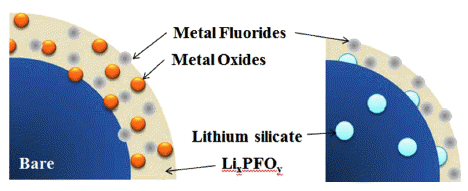
- 705 View
- 3 Download
- 1 Citations
-
 Abstract
Abstract
 PDF
PDF Lithium silicate, a lithium-ion conducting ceramic, is coated on a layer-structured lithium nickel manganese oxide (LiNi0.7Mn0.3O2). Residual lithium compounds (Li2CO3 and LiOH) on the surface of the cathode material and SiO2 derived from tetraethylorthosilicate are used as lithium and silicon sources, respectively. Powder X-ray diffraction and scanning electron microscopy with energy-dispersive spectroscopy analyses show that lithium silicate is coated uniformly on the cathode particles. Charge and discharge tests of the samples show that the coating can enhance the rate capability and cycle life performance. The improvements are attributed to the reduced interfacial resistance originating from suppression of solid-electrolyte interface (SEI) formation and dissolution of Ni and Mn due to the coating. An X-ray photoelectron spectroscopy study of the cycled electrodes shows that nickel oxide and manganese oxide particles are formed on the surface of the electrode and that greater decomposition of the electrolyte occurs for the bare sample, which confirms the assumption that SEI formation and Ni and Mn dissolution can be reduced using the coating process.
-
Citations
Citations to this article as recorded by- Artificial cathode-electrolyte interphases on nickel-rich cathode materials modified by silyl functional group
Hye Ji Song, Seol Heui Jang, Juhyeon Ahn, Si Hyoung Oh, Taeeun Yim
Journal of Power Sources.2019; 416: 1. CrossRef
- Artificial cathode-electrolyte interphases on nickel-rich cathode materials modified by silyl functional group
- [Korean]
- Electrochemical Behavior of Well-dispersed Catalysts on Ruthenium Oxide Nanofiber Supports
- Geon-Hyoung An, Hyo-Jin Ahn
- J Korean Powder Metall Inst. 2017;24(2):96-101. Published online April 1, 2017
- DOI: https://doi.org/10.4150/KPMI.2017.24.2.96
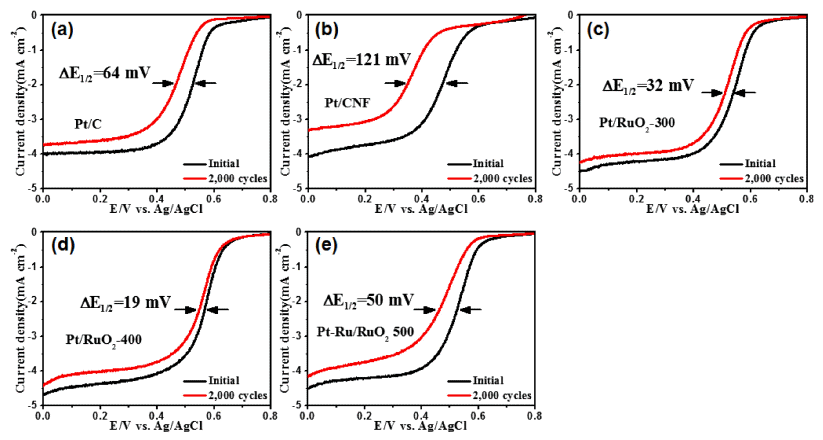
- 589 View
- 3 Download
- 3 Citations
-
 Abstract
Abstract
 PDF
PDF Well-dispersed platinum catalysts on ruthenium oxide nanofiber supports are fabricated using electrospinning, post-calcination, and reduction methods. To obtain the well-dispersed platinum catalysts, the surface of the nanofiber supports is modified using post-calcination. The structures, morphologies, crystal structures, chemical bonding energies, and electrochemical performance of the catalysts are investigated. The optimized catalysts show well-dispersed platinum nanoparticles (1-2 nm) on the nanofiber supports as well as a uniform network structure. In particular, the well-dispersed platinum catalysts on the ruthenium oxide nanofiber supports display excellent catalytic activity for oxygen reduction reactions with a half-wave potential (E1/2) of 0.57 V and outstanding long-term stability after 2000 cycles, resulting in a lower E1/2 potential degradation of 19 mV. The enhanced electrochemical performance for oxygen reduction reactions results from the well-dispersed platinum catalysts and unique nanofiber supports.
-
Citations
Citations to this article as recorded by- Fabrication of Porous Electrodes for Zinc-Ion Supercapacitors with Improved Energy Storage Performance
Geon-Hyoung An
Korean Journal of Materials Research.2019; 29(8): 505. CrossRef - Surface tailoring of zinc electrodes for energy storage devices with high-energy densities and long cycle life
Geon-Hyoung An, SeungNam Cha, Jung Inn Sohn
Applied Surface Science.2019; 467-468: 1157. CrossRef - Synthesis of Nitrogen Doped Protein Based Carbon as Pt Catalysts Supports for Oxygen Reduction Reaction
Young-geun Lee, Geon-hyeong An, Hyo-Jin Ahn
Korean Journal of Materials Research.2018; 28(3): 182. CrossRef
- Fabrication of Porous Electrodes for Zinc-Ion Supercapacitors with Improved Energy Storage Performance
- [Korean]
- Fabrication of Porous Polytetrafluoroethylene thin Film from Powder Dispersion-solution for Energy Nanogenerator Applications
- Il-Kyu Park
- J Korean Powder Metall Inst. 2017;24(2):102-107. Published online April 1, 2017
- DOI: https://doi.org/10.4150/KPMI.2017.24.2.102
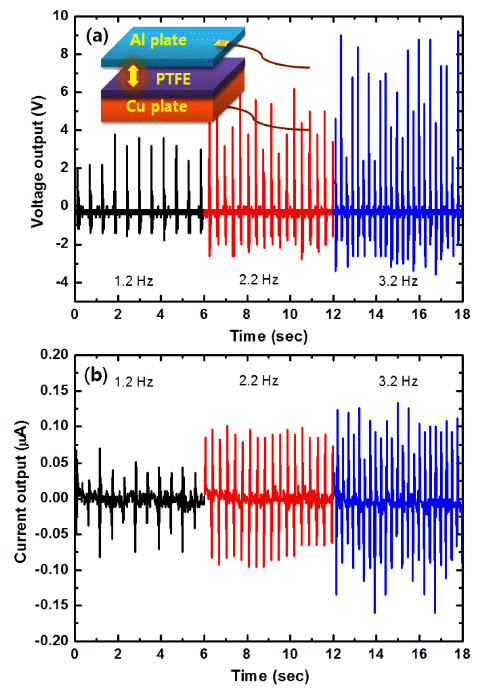
- 711 View
- 10 Download
- 1 Citations
-
 Abstract
Abstract
 PDF
PDF Porous polytetrafluoroethylene (PTFE) thin films are fabricated by spin-coating using a dispersion solution containing PTFE powders, and their crystalline properties are investigated after thermal annealing at various temperatures ranging from 300 to 500°C. Before thermal annealing, the film is densely packed and consists of many granular particles 200-300 nm in diameter. However, after thermal annealing, the film contains many voids and fibrous grains on the surface. In addition, the film thickness decreases after thermal annealing owing to evaporation of the surfactant, binder, and solvent composing the PTFE dispersion solution. The film thickness is systematically controlled from 2 to 6.5 μm by decreasing the spin speed from 1,500 to 500 rpm. A triboelectric nanogenerator is fabricated by spin-coating PTFE thin films onto polished Cu foils, where they act as an active layer to convert mechanical energy to electrical energy. A triboelectric nanogenerator consisting of a PTFE layer and Al metal foil pair shows typical output characteristics, exhibiting positive and negative peaks during applied strain and relief cycles due to charging and discharging of electrical charge carriers. Further, the voltage and current outputs increase with increasing strain cycle owing to accumulation of electrical charge carriers during charge-discharge.
-
Citations
Citations to this article as recorded by- Recent Development in Performance Enhancement of PVDF-Nanopowder Composite-based Energy Harvesting Devices
Geon-Ju Choi, Il-Kyu Park
Journal of Korean Powder Metallurgy Institute.2020; 27(3): 247. CrossRef
- Recent Development in Performance Enhancement of PVDF-Nanopowder Composite-based Energy Harvesting Devices
- [English]
- Optimization of Spark Plasma Sintering Temperature Conditions for Enhancement of Thermoelectric Performance in Gas-Atomized Bi0.5Sb1.5Te3 Compound
- Kwang-yong Jeong, Chul Hee Lee, Peyala Dharmaiah, Soon-Jik Hong
- J Korean Powder Metall Inst. 2017;24(2):108-114. Published online April 1, 2017
- DOI: https://doi.org/10.4150/KPMI.2017.24.2.108
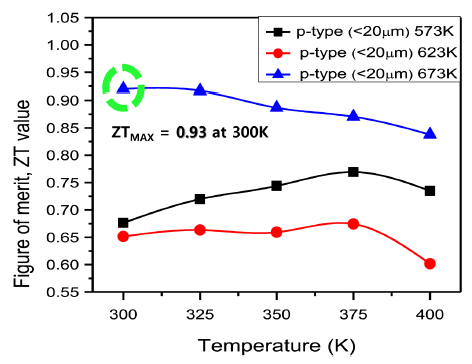
- 743 View
- 6 Download
- 3 Citations
-
 Abstract
Abstract
 PDF
PDF We fabricate fine (<20 μm) powders of Bi0.5Sb1.5Te3 alloys using a large-scale production method and subsequently consolidate them at temperatures of 573, 623, and 673 K using a spark plasma sintering process. The microstructure, mechanical properties, and thermoelectric properties are investigated for each sintering temperature. The microstructural features of both the powders and bulks are characterized by scanning electron microscopy, and the crystal structures are analyzed by X-ray diffraction analysis. The grain size increases with increasing sintering temperature from 573 to 673 K. In addition, the mechanical properties increase significantly with decreasing sintering temperature owing to an increase in grain boundaries. The results indicate that the electrical conductivity and Seebeck coefficient (217 μV/K) of the sample sintered at 673 K increase simultaneously owing to decreased carrier concentration and increased mobility. As a result, a high
ZT value of 0.92 at 300 K is achieved. According to the results, a sintering temperature of 673 K is preferable for consolidation of fine (<20 μm) powders.-
Citations
Citations to this article as recorded by- Complex microstructure induced high thermoelectric performances of p-type Bi–Sb–Te alloys
Eun-Ha Go, Babu Madavali, Min-Woo Shin, Sung Ho Song, Soon-Jik Hong
Materials Chemistry and Physics.2023; 307: 128156. CrossRef - Role of sintering temperature on electronic and mechanical properties of thermoelectric material: A theoretical and experimental study of TiCoSb half-Heusler alloy
Ajay Kumar Verma, Kishor Kumar Johari, Kriti Tyagi, Durgesh Kumar Sharma, Pawan Kumar, Sudhir Kumar, Sivaiah Bathula, S.R. Dhakate, Bhasker Gahtori
Materials Chemistry and Physics.2022; 281: 125854. CrossRef - Enhanced thermoelectric properties of Li and Mg co−substituted Bi2Sr2Co2O fabricated by combined conventional sintering and spark plasma sintering
K. Park, H.Y. Hong, S.Y. Gwon
Inorganic Chemistry Communications.2022; 145: 110005. CrossRef
- Complex microstructure induced high thermoelectric performances of p-type Bi–Sb–Te alloys
- [English]
- Investigation of Spark Plasma Sintering Temperature on Microstructure and Thermoelectric Properties of p-type Bi-Sb-Te alloys
- Jin-Koo Han, Dong-won Shin, Babu Madavali, Soon-Jik Hong
- J Korean Powder Metall Inst. 2017;24(2):115-121. Published online April 1, 2017
- DOI: https://doi.org/10.4150/KPMI.2017.24.2.115

- 822 View
- 4 Download
- 1 Citations
-
 Abstract
Abstract
 PDF
PDF In this work, p-type Bi−Sb−Te alloys powders are prepared using gas atomization, a mass production powder preparation method involving rapid solidification. To study the effect of the sintering temperature on the microstructure and thermoelectric properties, gas-atomized powders are consolidated at different temperatures (623, 703, and 743 K) using spark plasma sintering. The crystal structures of the gas-atomized powders and sintered bulks are identified using an X-ray diffraction technique. Texture analysis by electron backscatter diffraction reveals that the grains are randomly oriented in the entire matrix, and no preferred orientation in any unique direction is observed. The hardness values decrease with increasing sintering temperature owing to a decrease in grain size. The conductivity increases gradually with increasing sintering temperature, whereas the Seebeck coefficient decreases owing to increases in the carrier mobility with grain size. The lowest thermal conductivity is obtained for the bulk sintered at a low temperature (603 K), mainly because of its fine-grained microstructure. A peak ZT of 1.06 is achieved for the sample sintered at 703 K owing to its moderate electrical conductivity and sustainable thermal conductivity.
-
Citations
Citations to this article as recorded by- Influence of the SPS heating rate on the optical and mechanical properties of Y2O3-MgO nanocomposites
Seok-Min Yong
Journal of Ceramic Processing Research.2019; 20(1): 59. CrossRef
- Influence of the SPS heating rate on the optical and mechanical properties of Y2O3-MgO nanocomposites
- [English]
- Microstructure and Soft Magnetic Properties of Fe-6.5 wt.%Si Sheets Fabricated by Powder Hot Rolling
- Myung Shin Kim, Do Hun Kwon, Won Sik Hong, Hwi Jun Kim
- J Korean Powder Metall Inst. 2017;24(2):122-127. Published online April 1, 2017
- DOI: https://doi.org/10.4150/KPMI.2017.24.2.122
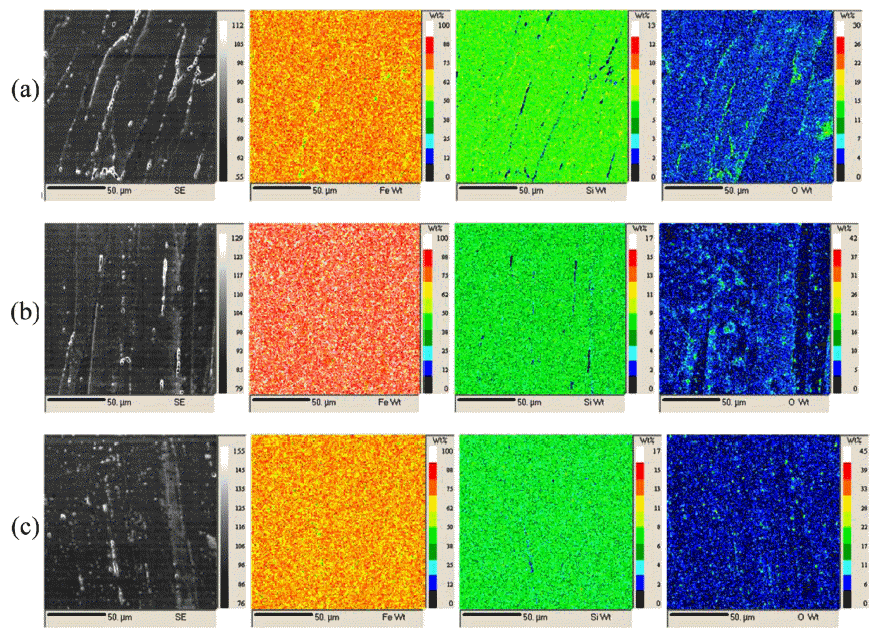
- 412 View
- 8 Download
-
 Abstract
Abstract
 PDF
PDF Fe-6.5 wt.% Si alloys are widely known to have excellent soft magnetic properties such as high magnetic flux density, low coercivity, and low core loss at high frequency. In this work, disc-shaped preforms are prepared by spark plasma sintering at 1223 K after inert gas atomization of Fe-6.5 wt.% Si powders. Fe-6.5 wt.% Si sheets are rolled by a powder hot-rolling process without cracking, and their microstructure and soft magnetic properties are investigated. The microstructure and magnetic properties (saturation magnetization and core loss) of the hot-rolled Fe-6.5 wt.% Si sheets are examined by scanning electron microscopy, electron backscatter diffraction, vibration sample magnetometry, and AC
B–H analysis. The Fe-6.5 wt.% Si sheet rolled at a total reduction ratio of 80% exhibits good soft magnetic properties such as a saturation magnetization of 1.74 T and core loss (W5/1000) of 30.7 W/kg. This result is caused by an increase in the electrical resistivity resulting from an increased particle boundary density and the oxide layers between the primary particle boundaries.
- [Korean]
- Stretch-Flangeability of Harmonic Structure Material Manufactured by Powder Metallurgy Method
- Jae Ik Yoon, Hak Hyeon Lee, Hyung Keun Park, Kei Ameyama, Hyoung Seop Kim
- J Korean Powder Metall Inst. 2017;24(2):128-132. Published online April 1, 2017
- DOI: https://doi.org/10.4150/KPMI.2017.24.2.128
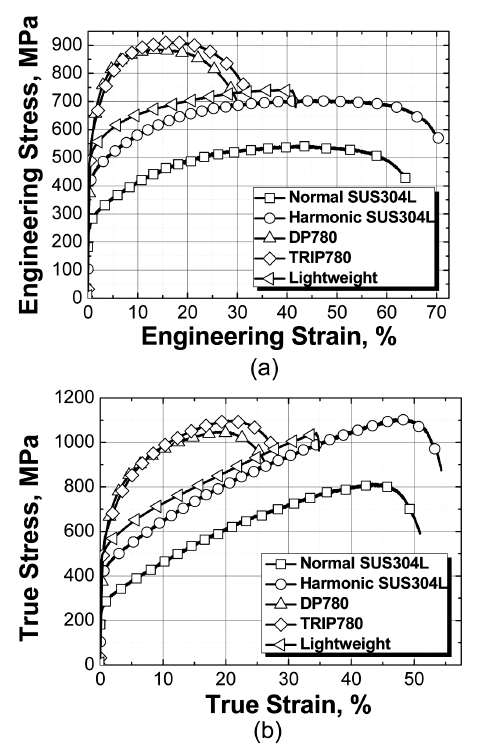
- 578 View
- 1 Download
-
 Abstract
Abstract
 PDF
PDF Harmonic structure materials are materials with a core–shell structure having a shell with a small grain size and a core with a relatively large grain size. They are in the spotlight because their mechanical properties reportedly feature strength similar to that of a sintered powder with a fine grain size and elongation similar to that of a sintered powder with a coarse grain size at the same time. In this study, the tensile properties, microstructure, and stretchflangeability of harmonic structure SUS304L made using powder metallurgy are investigated to check its suitability for automotive applications. The harmonic powders are made by mechanical milling and sintered using a spark plasma sintering method at 1173 K and a pressure of 50 MPa in a cylindrical die. The sintered powders of SUS304L having harmonic structure (harmonic SUS304L) exhibit excellent tensile properties compared with sintered powders of SUS304L having homogeneous microstructure. In addition, the harmonic SUS304L has excellent stretch-flangeability compared with commercial advanced high-strength steels (AHSSs) at a similar strength grade. Thus, the harmonic SUS304L is more suitable for automotive applications than conventional AHSSs because it exhibits both excellent tensile properties and stretch-flangeability.
- [Korean]
- High Temperature Oxidation Behavior of Fe-14Cr Ferritic Oxide Dispersion Strengthened Steels Manufactured by Mechanical Alloying Process
- Young-Kyun Kim, Jong-Kwan Park, Hwi-Jun Kim, Man-Sik Kong, Kee-Ahn Lee
- J Korean Powder Metall Inst. 2017;24(2):133-140. Published online April 1, 2017
- DOI: https://doi.org/10.4150/KPMI.2017.24.2.133
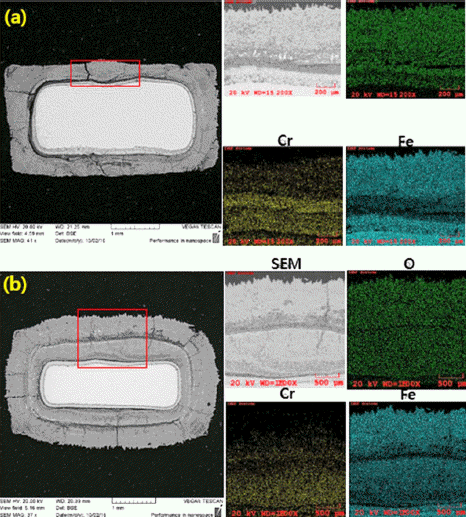
- 348 View
- 3 Download
- 1 Citations
-
 Abstract
Abstract
 PDF
PDF This study investigates the oxidation properties of Fe-14Cr ferritic oxide-dispersion-strengthened (ODS) steel at various high temperatures (900, 1000, and 1100°C for 24 h). The initial microstructure shows that no clear structural change occurs even under high-temperature heat treatment, and the average measured grain size is 0.4 and 1.1 μm for the as-fabricated and heat-treated specimens, respectively. Y–Ti–O nanoclusters 10–50 nm in size are observed. High-temperature oxidation results show that the weight increases by 0.27 and 0.29 mg/cm2 for the asfabricated and heat-treated (900°C) specimens, and by 0.47 and 0.50 mg/cm2 for the as-fabricated and heat-treated (1000°C) specimens, respectively. Further, after 24 h oxidation tests, the weight increases by 56.50 and 100.60 mg/cm2 for the as-fabricated and heat-treated (1100°C) specimens, respectively; the latter increase is approximately 100 times higher than that at 1000°C. Observation of the surface after the oxidation test shows that Cr2O3 is the main oxide on a specimen tested at 1000°C, whereas Fe2O3 and Fe3O4 phases also form on a specimen tested at 1100°C, where the weight increases rapidly. The high-temperature oxidation behavior of Fe-14Cr ODS steel is confirmed to be dominated by changes in the Cr2O3 layer and generation of Fe-based oxides through evaporation.
-
Citations
Citations to this article as recorded by- Microstructure and Wear Properties of Oxide Dispersion Strengthened Steel Powder Added Steel-Based Composite Material for Automotive Part
Young-Kyun Kim, Jong-Kwan Park, Kee-Ahn Lee
journal of Korean Powder Metallurgy Institute.2018; 25(1): 36. CrossRef
- Microstructure and Wear Properties of Oxide Dispersion Strengthened Steel Powder Added Steel-Based Composite Material for Automotive Part
- [Korean]
- The Preparation and Growth Mechanism of the Recovered Bi2Te3 Particles with Respect to Surfactants
- Hyeongsub So, Eunpil Song, Yong-Ho Choa, Kun-Jae Lee
- J Korean Powder Metall Inst. 2017;24(2):141-146. Published online April 1, 2017
- DOI: https://doi.org/10.4150/KPMI.2017.24.2.141

- 768 View
- 9 Download
- 1 Citations
-
 Abstract
Abstract
 PDF
PDF Bi2Te3 powders are recovered by wet chemical reduction for waste n-type thermoelectric chips, and the recovered particles with different morphologies are prepared using various surfactants such as cetyltrimethylammonium bromide (CTAB), sodium dodecylbenzenesulfonate (SDBS), and ethylenediaminetetraacetic acid (EDTA). When citric acid is added as the surfactant, the shape of the aggregated particles shows no distinctive features. On the other hand, rod-shaped particles are formed in the sample with CTAB, and sheet-like particles are synthesized with the addition of SDBS. Further, particles with a tripod shape are observed when EDTA is added as the surfactant. The growth mechanism of the particle shapes depending on the surfactant is investigated, with a focus on the nucleation and growth phenomena. These results help to elucidate the intrinsic formation mechanism of the rod, plate, and tripod structures of the Bi2Te3 recovered by the wet reduction process.
-
Citations
Citations to this article as recorded by- Recovery of Barium, Nickel, and Titanium Powders from Waste MLCC
Haein Shin, Kun-Jae Lee
Journal of Powder Materials.2024; 31(5): 374. CrossRef
- Recovery of Barium, Nickel, and Titanium Powders from Waste MLCC
- [Korean]
- Effect of Organic Additives on Microstructure and Green Density of Zirconia Granules Using Water Solvent
- Ji-Hwan Jung, Sang-Jin Lee
- J Korean Powder Metall Inst. 2017;24(2):147-152. Published online April 1, 2017
- DOI: https://doi.org/10.4150/KPMI.2017.24.2.147
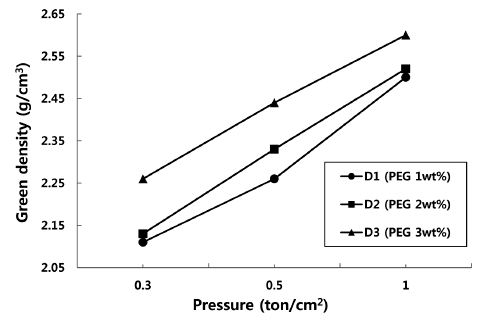
- 1,194 View
- 31 Download
- 2 Citations
-
 Abstract
Abstract
 PDF
PDF Spherical-type zirconia granules are successfully fabricated by a spray-drying process using a water solvent slurry, and the change in the green density of the granule powder compacts is examined according to the organic polymers used. Two organic binders, polyvinyl alcohol (PVA) and 2-hydroxyethyl methacrylate (HEMA), which are dissolved in a water solvent and have different degrees of polymerization, are applied to the slurry with a plasticizer (polyethylene glycol). The granules employing a binder with a higher degree of polymerization (PVA) are not broken under a uniaxial press; consequently, they exhibit a poor green density of 2.4 g/cm3. In contrast, the granule powder compacts employing a binder with a lower degree of polymerization (HEMA) show a higher density of 2.6 g/cm3 with an increase in plasticizer content. The packing behavior of the granule powders for each organic polymer system is studied by examining the microstructure of the fracture surface at different applied pressures.
-
Citations
Citations to this article as recorded by- Effects of TiO2 Addition and Processing Variables on the Properties of Black Aluminum Nitride
Min-Kwon Park, Sin-Il Go, Kwang-Hee Han, Sang-Jin Lee
Korean Journal of Materials Research.2025; 35(8): 345. CrossRef - Uniaxial compaction and sintering of ZrO2−3 mol% Y2O3 using rubber and PEG solutions as binders
M.I. Dvornik, O.O. Shichalin, E.A. Mikhailenko, A.A. Burkov, S.V. Nikolenko, N.M. Vlasova, E.V. Chernyakov, A.A. Gnidenko, P.G. Chigrin, I. Yu Buravlev, N.S. Konovalova
Materials Chemistry and Physics.2024; 328: 129981. CrossRef
- Effects of TiO2 Addition and Processing Variables on the Properties of Black Aluminum Nitride
- [Korean]
- Research Trends in Powder Materials for Solution-based Transparent Conducting Electrode
- Bon-Ryul Koo, Hyo-Jin Ahn
- J Korean Powder Metall Inst. 2017;24(2):153-163. Published online April 1, 2017
- DOI: https://doi.org/10.4150/KPMI.2017.24.2.153
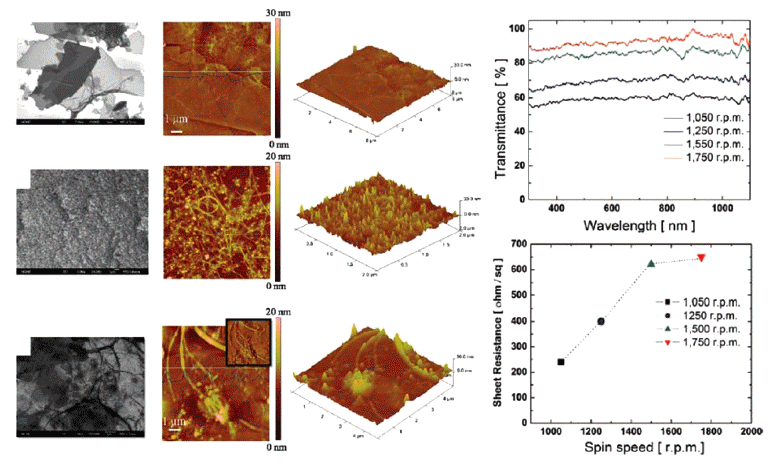
- 428 View
- 3 Download
- 1 Citations
-
 Abstract
Abstract
 PDF
PDF Transparent conducting electrodes (TCEs) are attracting considerable attention as an important component for emerging optoelectronic applications such as liquid crystal displays, touch panels, and solar cells owing to their attractive combination of low resistivity (< 10-3 Ω cm) and high transparency (>80%) in the visible region. The solutionbased process has unique properties of an easy fabrication procedure, scalability, and low cost compared to the conventional vacuum-based process and may prove to be a useful process for fabricating TCEs for future optoelectronic applications demanding large scale and flexibility. In this paper, we focus on the introduction of a solution-based process for TCEs. In addition, we consider the powder materials used to fabricate solution-based TCEs and strategies to improve their transparent conducting properties.
-
Citations
Citations to this article as recorded by- Electrically conductive and anti-corrosive coating on copper foil assisted by polymer-nanocomposites embedded with graphene
Han Kim, Hyemin Lee, Hyo-Ryoung Lim, Hong-Baek Cho, Yong-Ho Choa
Applied Surface Science.2019; 476: 123. CrossRef
- Electrically conductive and anti-corrosive coating on copper foil assisted by polymer-nanocomposites embedded with graphene
TOP
 kpmi
kpmi




 First
First Prev
Prev


